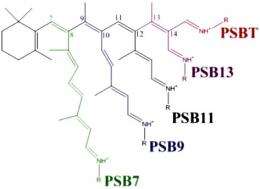November 17, 2011 feature
Scientists solve mystery of the eye

(PhysOrg.com) -- Scientists have a good overall understanding of human vision: when light enters our eyes, it is focused by the lens and strikes the retina in the back of the eye. The light causes some of the millions of photoreceptor cells that line the retina to undergo a chemical change, which send a message through the optic nerve fiber to the brain, which creates a picture. However, there are still a few unresolved questions in the details of the vision process, one of which is why the eye evolved to use a certain light-absorbing chromophore called 11-cis-retinal instead of one of its isomers (i.e., molecules with the same atoms but in different arrangements), such as 7-cis, 9-cis, or 13-cis.
Chemists Sivakumar Sekharan from Emory University in Atlanta, Georgia, and Keiji Morokuma from Emory University and Kyoto University in Kyoto, Japan, describe the eye’s use of 11-cis-retinal as “one of the basic and unresolved puzzles in the chemistry of vision.” But by taking advantage of the rapid advances in hybrid quantum mechanics/molecular mechanics (QM/MM) computational modeling, the researchers have found that the answer to this puzzle lies in electrostatic interactions in the retina. Their study is published in a recent issue of the Journal of the American Chemical Society.
The retina contains light-sensitive photoreceptor cells known as rods and cones, which convert incoming light into electrical impulses that are sent to the brain. On the top of every rod and cone is a region that contains opsin proteins bound to 11-cis-retinal chromophores, which together are called rhodopsin. When light strikes the retina, the 11-cis-retinal chromophores absorb the light, which causes them to undergo an isomerization and change their molecular configuration from 11-cis-retinal to all-trans-retinal in a matter of picoseconds. The difference between these two isomers involves the positions of the hydrogen atoms, a shape change that causes the opsin protein to change shape in response. The opsin shape change, in turn, leads to a cascade of biochemical reactions in the photoreceptor cell that ultimately generate an electrical impulse.
Since the 11-cis-retinal is the retina’s first responder to incoming light, its unique geometric configuration clearly plays an important role in the vision process. However, theoretically there are a handful of other retinal isomers that seem capable of performing this task, yet for some reason photoreceptor cells only function with 11-cis-retinal (and the corresponding 11-cis-rhodopsin).
“Because the primary event in vision involves no breaking of chemical bonds but only a conformational change in the shape of the molecule from bent cis to the distorted all-trans form, scientists wondered why 7-cis-, 9-cis- or 13-cis- isomers could not achieve this goal,” Sekharan told PhysOrg.com.
To answer this question, the researchers built computational models of the rhodopsin found in the eyes of cows, monkeys, and squids. While all known animals’ eyes use 11-cis-retinal, the opsin in different animals contains different numbers and positions of amino acids. Using a cutting-edge QM/MM modeling method called ONIOM (Our own N-layered Integrated Molecular Orbital), the researchers prepared models that matched different animals’ opsins with 7-cis, 9-cis, 11-cis, and 13-cis molecules serving as chromophores. In these artificial rhodopsins, the researchers analyzed the structure, stability, energetics, and spectroscopy to try to find out what makes 11-cis-retinal nature’s preferred isomer.
The results of the modeling showed that differences in the electrostatic interactions between the opsin protein and the retinal chromophore played the biggest factor in the natural selection of 11-cis-retinal over the other cis isomers. Due to electric charges, the link between 11-cis-retinal and opsin has a higher stability than the links between other cis isomers and opsin, making it the most favorable choice.
“Our results show that the strong electrostatic interaction between retinal and opsin favors the natural selection of 11-cis- over other cis-isomers and arguably prepares the chromophore for the upcoming photochemical event,” Sekharan said. “This indeed is very surprising given the fact that, outside the protein environment, 11-cis-retinal is one of the least stable isomers. Apparently, our results on cow, monkey and squid demonstrate that organisms everywhere may tend to gravitate towards common selection.”
Sekharan added that the results not only provide a better understanding of the eyes on a molecular level, but could also have applications for artificial retinas.
“Because rhodopsin serves as a decisive crossing point between an organism and its environment, we have been always impressed with this interesting interface by seeing it, say, from the outside and not from the inside,” he said. “Using the ONIOM-QM/MM method we developed, we can ‘enter’ deep into the dark side of this fascinating molecule. One of interesting findings to emerge out of our investigation is that 9-cis-retinal is only slightly higher in energy compared to 11-cis-retinal. This provides strong evidence for the presence of 9-cis-rhodopsin in nature, which in turn may well aid in optimizing the parameters required for designing artificial retinas.”
More information: Sivakumar Sekharan and Keiji Morokuma. “Why 11-cis-Retinal? Why Not 7-cis-, 9-cis-, or 13-cis-Retinal in the Eye?” Journal of the American Chemical Society. DOI:10.1021/ja208789h
Journal information: Journal of the American Chemical Society
Copyright 2011 PhysOrg.com.
All rights reserved. This material may not be published, broadcast, rewritten or redistributed in whole or part without the express written permission of PhysOrg.com.


















